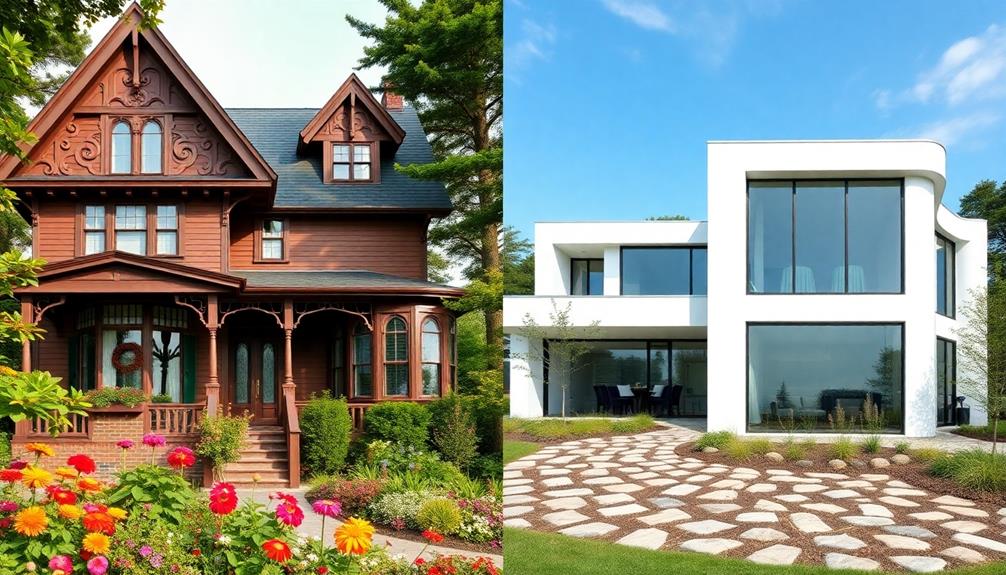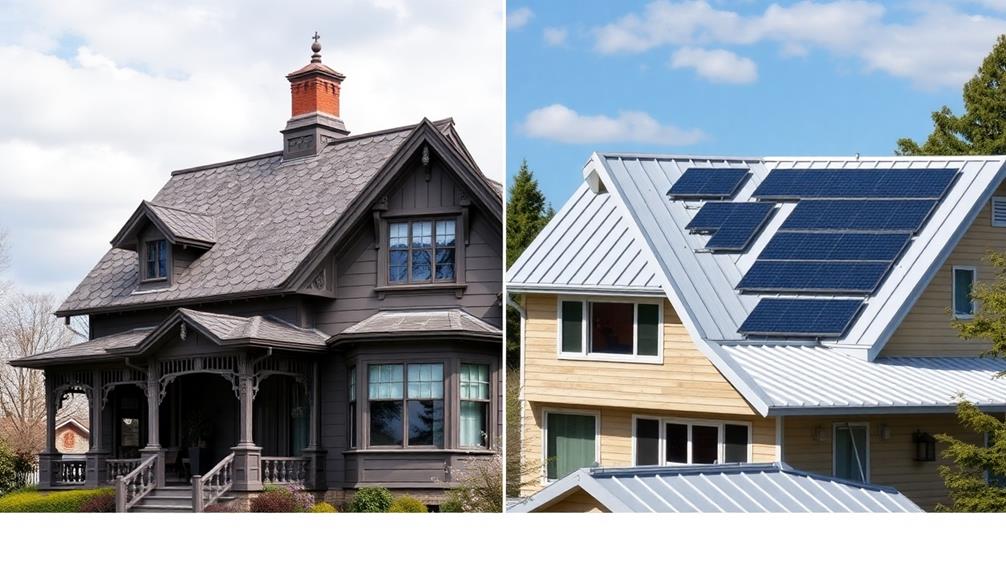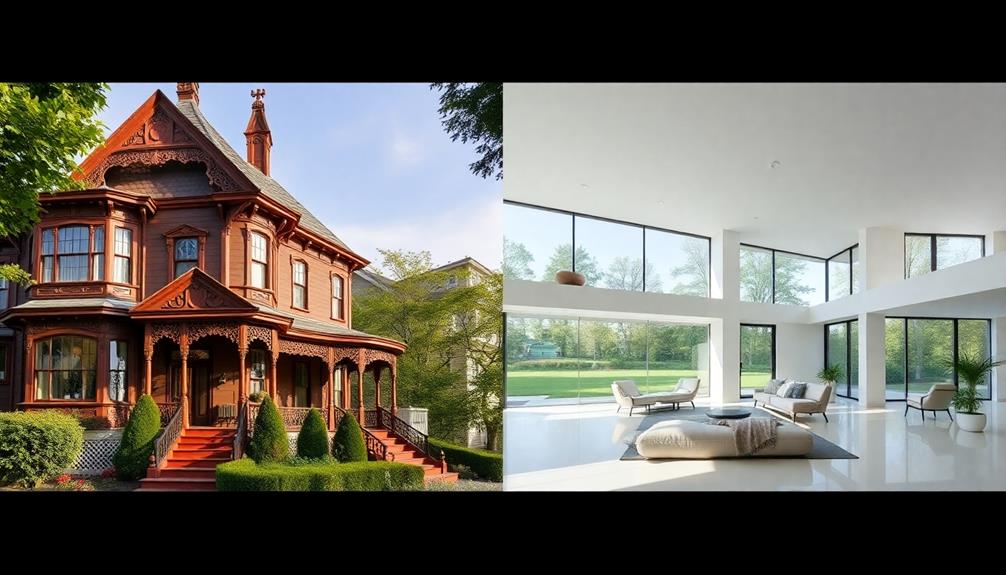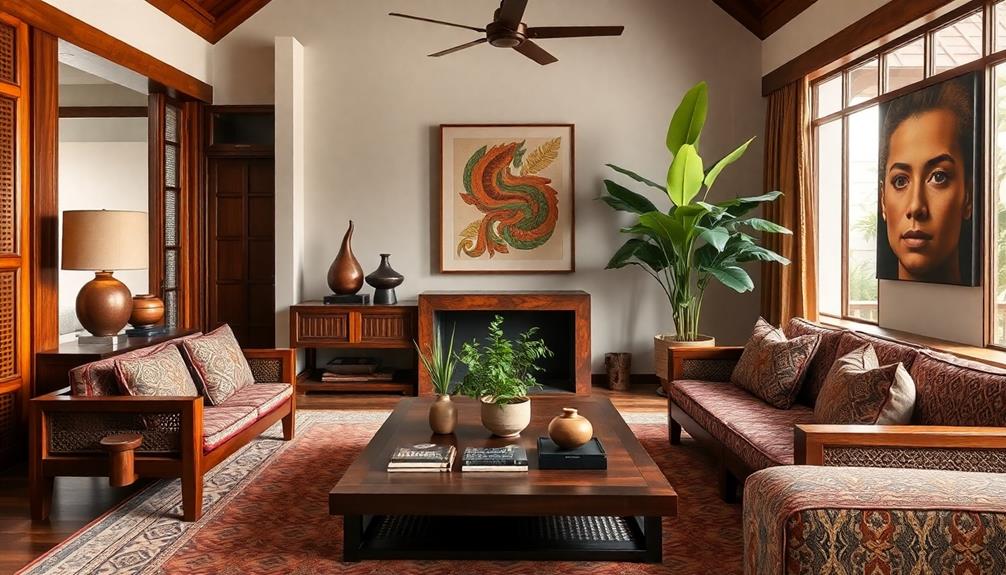When comparing old homes to modern ones, you’ll notice significant differences in style, technology, and maintenance. Older homes showcase detailed architectural elements and historic charm, while modern designs prioritize sleek lines and spacious layouts. Functionality also varies; modern homes are equipped with smart systems and energy-efficient appliances, enhancing convenience in everyday life. Additionally, differences in structural integrity are evident, with older homes typically requiring more maintenance due to aging materials. Curious about how these distinctions can affect your decision? There is a wealth of information to discover about the advantages and drawbacks of each style.
Key Takeaways
- Traditional homes feature intricate designs and historical significance, while modern homes prioritize clean lines and open spaces.
- Modern homes incorporate advanced technology and energy-efficient appliances, unlike older homes that often lack these conveniences.
- Structural integrity is enhanced in modern homes through advanced construction methods, whereas older homes may suffer from aging materials and weaker walls.
- Foundations in modern homes use reinforced materials for durability, while older homes may have settling issues due to outdated construction techniques.
- Maintenance needs differ significantly, with older homes requiring more frequent repairs and upgrades compared to the warranties and durability of modern homes.
Architectural Style Differences

When you compare old homes to modern ones, the differences in architectural styles stand out. Traditional houses often showcase classic designs like Victorian or Colonial, emphasizing intricate details and distinct room separations. In contrast, modern homes tend to focus on minimalism, clean lines, and open floor plans, prioritizing functionality over ornate designs. Materials such as glass, steel, and concrete are often used in contemporary architecture, giving these homes a sleek and streamlined appearance. When considering traditional vs modern homes, it’s clear that personal tastes and lifestyle preferences play a major role in the choice between these two distinct styles.
You'll notice ornate moldings, high ceilings, and unique craftsmanship that reflect their historical significance. In contrast, modern homes focus on clean lines and simplicity. They prioritize functionality and open spaces, using industrial materials like steel and concrete that create a stark contrast to the local materials found in older constructions.
This evolution in architecture mirrors society's changing needs, embracing sustainability while discarding some of the ornate features of the past. Ultimately, these style differences highlight the diverse approaches to home design across time.
Technology and Amenities Variances

In today's homes, technology and amenities are game-changers that set modern residences apart from their older counterparts.
You'll find modern houses equipped with smart home systems that allow for convenience and control at your fingertips. Features like energy-efficient appliances, central heating, and smart thermostats help save on utility bills while enhancing comfort.
High-speed internet connectivity is standard in contemporary homes, enabling seamless communication and entertainment.
In contrast, older homes often lack these modern conveniences, requiring extensive upgrades to meet today's standards. Retrofitting an old home can improve its amenities but may involve significant effort and cost.
Structural Integrity Variances

Structural integrity varies considerably between old and modern homes, impacting their safety and longevity.
In older homes, you might notice weaker wall construction techniques and aging materials that can compromise stability. Traditional roofing materials may also suffer from wear and tear, leading to leaks or structural issues.
On the other hand, modern homes utilize advanced construction methods and materials that enhance durability. With innovations in design, you'll find better overall structural integrity, thanks to engineered wood and steel reinforcements.
Additionally, maintenance needs differ; older homes often require more frequent repairs. Understanding these variances helps you assess the safety and longevity of your living space, whether you're considering an upgrade or simply weighing your options between old and new.
Foundation Strength Differences

Foundation strength plays an essential role in the stability of a home, and there's a marked difference between old and modern constructions.
Modern foundations typically utilize reinforced concrete and steel, providing enhanced durability that meets stringent building codes. This guarantees your home can withstand various environmental factors over time.
In contrast, older foundations, often made from stone, brick, or wood, can be more susceptible to settling and decay, leading to potential structural issues.
The advanced construction techniques used today not only increase foundation lifespan but also improve overall safety.
If you're considering purchasing or upgrading a home, understanding these foundation differences can help you make informed decisions about long-term stability and maintenance.
Roofing Materials Evolution

As you explore the differences between old and modern homes, consider how roofing materials have evolved alongside foundational advancements.
Traditional roofs often relied on materials like wood shingles, slate, or clay tiles, which, while beautiful, may not offer the durability you need today.
Modern roofing options have emerged, providing enhanced performance and longevity. Here are some key advancements:
- Asphalt shingles: Affordable and widely used.
- Metal roofing: Durable and weather-resistant.
- Solar panels: Sustainable energy generation.
- Synthetic materials: Mimic traditional styles with better durability.
- Green roofs: Promote insulation and biodiversity.
This evolution in roofing not only boosts weather resistance but also contributes to the overall structural integrity of your home.
Choosing the right roofing material can greatly impact your home's longevity and maintenance needs.
Energy Efficiency Differences

Recognizing the importance of energy efficiency in today's world, modern homes markedly outperform older houses in this aspect.
They incorporate advanced insulation technologies and energy-efficient appliances that considerably reduce utility costs. You'll find features like smart thermostats and LED lighting, which further enhance energy savings.
In contrast, older homes often lack these modern upgrades, leading to higher energy consumption and costs. Sustainable design practices in modern architecture also minimize environmental impact, making them more appealing to eco-conscious homeowners.
If you own an older home, consider an energy audit; upgrading to current standards can greatly improve efficiency and comfort.
Embracing these improvements can't only save money but also contribute positively to the environment.
Maintenance and Upkeep Considerations

When it comes to maintenance and upkeep, older homes often demand more attention due to aging materials and potential wear and tear.
You'll likely find yourself investing time and money into repairs. In contrast, modern homes generally require less maintenance, thanks to newer materials and technologies.
Here are some key considerations:
- Frequent inspections are essential for older homes to catch issues early.
- Upgrading systems (like plumbing and electrical) can be a significant expense.
- Landscaping and exterior maintenance might be more demanding for older properties.
- Modern homes typically have warranties on materials and appliances.
- Energy efficiency upgrades can mitigate long-term costs in older homes.
Choosing between old and modern houses involves weighing these upkeep factors carefully.
Frequently Asked Questions
How Do Historical Home Prices Compare to Modern Homes?
When you compare historical home prices to modern homes, you'll often find that older properties can be more affordable upfront, but renovation costs and maintenance can add up, making modern homes more appealing long-term.
What Are the Common Renovation Costs for Old Homes?
Renovating an old home can feel like unearthing buried treasure. You'll likely face costs from plumbing upgrades to roof replacements, ranging from $15,000 to $100,000, depending on the home's condition and your vision.
Are There Tax Benefits for Restoring Historic Homes?
Yes, you can often receive tax benefits for restoring historic homes. These incentives might include property tax reductions or credits, encouraging you to preserve the architectural heritage while minimizing your financial burden during the renovation process.
How Do Neighborhood Aesthetics Differ Between Old and Modern Homes?
Like a patchwork quilt, neighborhood aesthetics blend old and modern homes, creating unique visual stories. You'll notice traditional designs evoke nostalgia, while sleek, modern lines offer freshness. Each contributes distinct charm to the community's character.
What Challenges Exist When Selling an Old Home?
When selling an old home, you might face issues like outdated features, maintenance concerns, and potential buyer apprehension. Highlighting charm and character can help, but you'll need to address necessary repairs and upgrades.
Conclusion
In exploring old homes versus modern homes, you uncover a fascinating blend of history and innovation. Did you know that homes built before 1950 typically have 30% more wood in their construction compared to modern homes? This not only reflects the craftsmanship of the past but also highlights the structural differences between eras. Whether you're drawn to the charm of vintage architecture or the sleekness of contemporary design, both styles offer unique stories and experiences worth appreciating.









